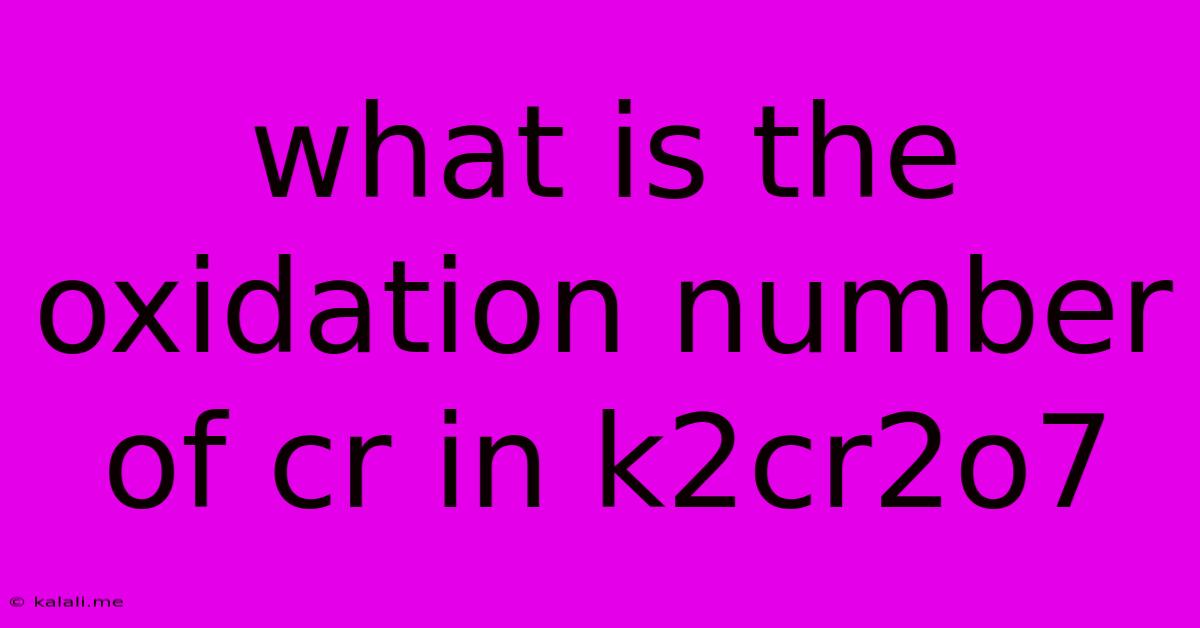What Is The Oxidation Number Of Cr In K2cr2o7
Kalali
Jun 15, 2025 · 3 min read

Table of Contents
What is the Oxidation Number of Cr in K₂Cr₂O₇? A Comprehensive Guide
Determining the oxidation number of chromium (Cr) in potassium dichromate (K₂Cr₂O₇) is a fundamental concept in chemistry. This article will provide a step-by-step guide to calculating this oxidation number, explaining the underlying principles and offering helpful tips for similar calculations. Understanding this concept is crucial for mastering redox reactions and other advanced chemistry topics.
Potassium dichromate is an orange, crystalline ionic compound commonly used as an oxidizing agent in various chemical reactions. To find the oxidation number of chromium, we need to consider the oxidation numbers of the other elements present and apply the rules for assigning oxidation numbers.
Understanding Oxidation Numbers
Oxidation numbers, also known as oxidation states, represent the hypothetical charge an atom would have if all bonds were completely ionic. They are a useful tool for tracking electron transfer in chemical reactions. Here are some key rules:
- Rule 1: The oxidation number of an element in its free state is always zero (e.g., O₂, Cl₂, Cr).
- Rule 2: The oxidation number of a monatomic ion is equal to its charge (e.g., Na⁺ = +1, Cl⁻ = -1).
- Rule 3: The oxidation number of hydrogen (H) is usually +1, except in metal hydrides where it is -1.
- Rule 4: The oxidation number of oxygen (O) is usually -2, except in peroxides (-1) and superoxides (-1/2).
- Rule 5: The sum of the oxidation numbers of all atoms in a neutral molecule is zero.
- Rule 6: The sum of the oxidation numbers of all atoms in a polyatomic ion is equal to the charge of the ion.
Calculating the Oxidation Number of Cr in K₂Cr₂O₇
Let's apply these rules to determine the oxidation number of chromium in K₂Cr₂O₇:
-
Identify the known oxidation numbers:
- Potassium (K) is an alkali metal, and its oxidation number is always +1.
- Oxygen (O) usually has an oxidation number of -2 (we assume no peroxides or superoxides are present here).
-
Set up an algebraic equation: Since K₂Cr₂O₇ is a neutral compound, the sum of the oxidation numbers of all atoms must equal zero. Let 'x' represent the oxidation number of Cr. We have:
2(+1) + 2(x) + 7(-2) = 0
-
Solve for x:
2 + 2x - 14 = 0 2x = 12 x = +6
Therefore, the oxidation number of chromium (Cr) in K₂Cr₂O₇ is +6.
Further Applications and Importance
Understanding how to calculate oxidation numbers is critical for:
- Balancing redox reactions: Identifying the changes in oxidation numbers helps in balancing complex redox reactions, ensuring that electrons are conserved.
- Predicting reactivity: Oxidation states indicate the potential for an atom to gain or lose electrons, which influences its chemical reactivity.
- Naming compounds: Oxidation numbers are often incorporated into the names of compounds, particularly for transition metals with variable oxidation states.
This detailed explanation provides a clear understanding of how to determine the oxidation number of chromium in potassium dichromate. Remember to practice applying these rules to other compounds to solidify your understanding of this important chemical concept. By mastering this fundamental skill, you'll be well-equipped to tackle more advanced chemistry topics.
Latest Posts
Latest Posts
-
Which Of These Has Radial Symmetry
Jun 15, 2025
-
Which Of These Statements Is Not True About Project Scheduling
Jun 15, 2025
-
How To Count The Highlighted Cells In Excel
Jun 15, 2025
-
What Is The Oxidation Number Of Fe
Jun 15, 2025
-
Which State Of Matter Has The Highest Kinetic Energy
Jun 15, 2025
Related Post
Thank you for visiting our website which covers about What Is The Oxidation Number Of Cr In K2cr2o7 . We hope the information provided has been useful to you. Feel free to contact us if you have any questions or need further assistance. See you next time and don't miss to bookmark.